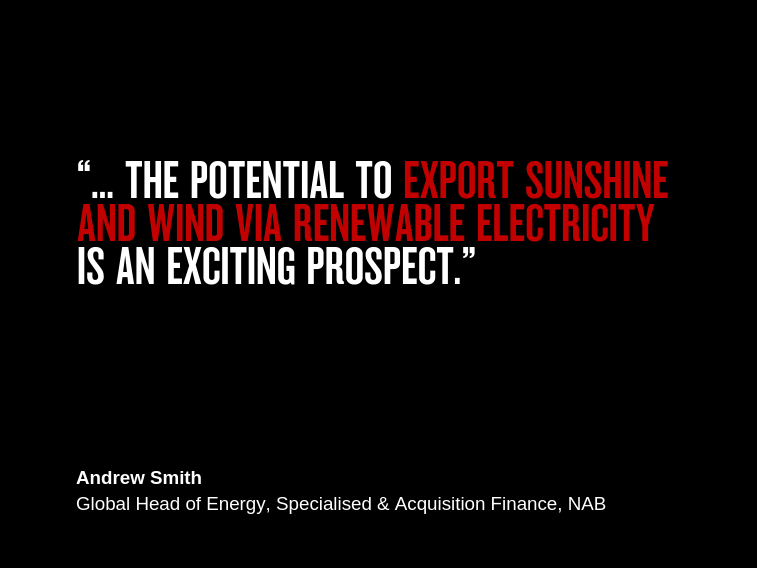Global growth headed for a H2 trough as tariffs start to bite


Insight
Australia’s energy landscape is undergoing a significant transformation which includes the increased penetration of renewable energy technologies.

The renewable energy sector is witnessing record levels of investment. The Clean Energy Council estimates there are about 80 projects in construction (or due to start soon) in Australia which will deliver over $20 billion worth of investment.* Andrew Smith, Global Head of Energy, Specialised & Acquisition Finance at National Australia Bank, says this is “the biggest renewable energy boom Australia has ever seen.”
Looking forward, Smith expects renewable projects to continue to progress through the development cycle into construction, although the pace will partly depend how much policy certainty governments can give the renewables sector.
“There’s a tremendous opportunity for further deployment of renewables in Australia, and the reason I say that is, due to our historic reliance on ageing coal-fired generation we have one of the most carbon-intensive electricity grids in the world.
“Fundamentally, utility-scale wind and solar projects are the cheapest new entrant and we continue to see innovation leading to further cost declines” Smith said
Despite the rapid build out of large-scale renewable generation, one of the key challenges for project developers is securing a long-term power purchase agreement (PPA) with a credit worthy counter-party. “There’s a scarcity of PPAs which is driving down PPA prices and ensuring only the lowest cost projects on the supply curve come forward. PPAs are critical to unlocking renewable projects as they transfer market price risk which stabilises the projects’ cashflows and allows developers to access deep pools of efficiently priced debt and equity capital,” Smith says.
In addition to traditional energy retailers and state governments, corporates are now entering into PPAs. “Corporate interest is driven by green agendas and to hedge against increases in wholesale electricity costs.
“One of the perceptions among corporates is that renewable power is more expensive which isn’t the case,” Smith says. In fact, a recent NAB survey of 900 small, medium and large organisations found that only about a third of Australian businesses had renewable electricity in their energy mix and nearly half of businesses said cost was a barrier to using more renewable power.
With increased penetration of intermittent renewable generation comes the requirement for firming capacity – and not just firm (or baseload) capacity. Playing into this is the rise of flexible generation. Smith expects to see renewable energy investors deploy capital into flexible generation technologies such as fast start gas, battery storage and pumped storage. This can provide a hedge for renewable investors as value can shift out of correlated renewable electricity markets and into shoulder/peak markets. Investing in flexible generation will allow investors to capture that shift.
“Interest in hydrogen projects is emerging and investors are looking to experiment,” Smith says. Potential opportunities exist to incorporate an electrolyser at a renewable site and splitting water into hydrogen (and oxygen) and injecting it into the gas grid or large scale projects with an Asian export focus.
The National Electricity Market was originally designed to facilitate the transfer of bulk electricity from centralised baseload generators to end users. We’re now seeing renewable generators connecting to weaker parts of the grid. A critical element of a projects’ development is an assessment of the grid. “Grid connection arrangements, distribution/transmission loss factors and the potential for constraints remain a key area of focus for capital providers as it can have a significant impact on project revenues,” Smith said.
“There’s no shortage of mega projects in various stages of development which can change the landscape. While not all of them may ultimately proceed, they’re certainly worth keeping an eye on,” Smith said. Some projects of note include Snowy 2.0, Tasmania’s Battery of the Nation (pumped hydro and Basslink 2), the NSW – SA interconnector, the Aurora Solar Thermal project, the Star of the South offshore wind farm and projects to export renewable power to Indonesia. “One idea I find really interesting is the potential to export renewable power to Indonesia. Australia is the world’s second largest exporter of thermal coal, the second largest exporter of LNG and the potential to export sunshine and wind via renewable electricity is an exciting prospect,” Smith said.
2019 will also see continued strong demand from domestic and international banks to participate in sensibly-structured project financings. For banks, financing renewable energy projects is a Shared Value Initiative, where in addition to generating a return on capital they also help address a major societal issue – in this instance climate change. “NAB’s been active in the sector for 15 years and has closed over 120 financings. We’re committed to the sector,” Smith says.
Historically the project finance market has been dominated by large commercial banks. “What we’re now witnessing are non-bank lenders looking to participate in renewable transactions which we see as a positive development and one we’re trying to facilitate. Additional demand for debt should ultimately lower cost and enable a broader product suite which can only be a good thing for the industry,” Smith said.
Speak to a specialist*https://www.cleanenergycouncil.org.au/resources/project-tracker
© National Australia Bank Limited. ABN 12 004 044 937 AFSL and Australian Credit Licence 230686.